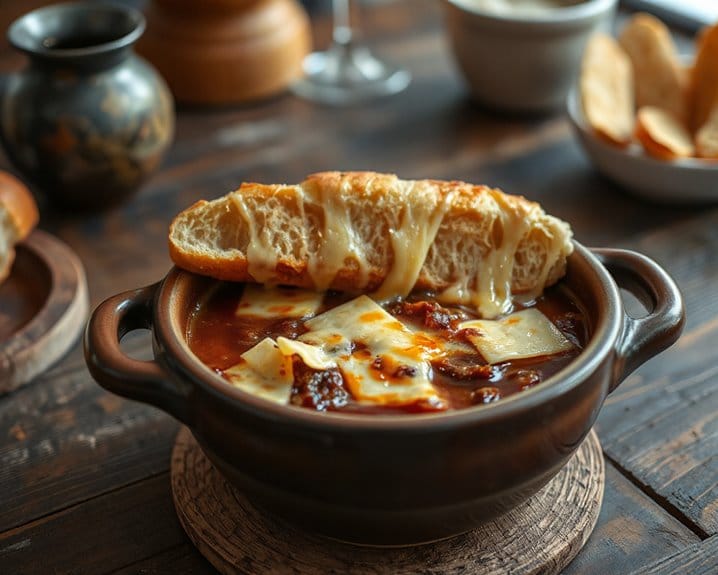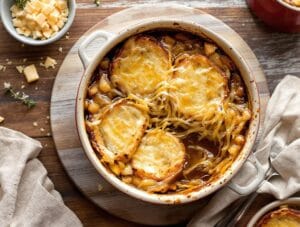Why You’ll Love this Classic French Onion Soup
Who doesn’t crave the comfort of a steaming bowl of French onion soup on a chilly evening? This timeless recipe transforms simple ingredients into something truly magical. The caramelized red onions develop an incredible depth of flavor, slowly cooking down until they’re sweet, rich, and deeply browned.
What makes this version special is the combination of both chicken and beef broths, giving you a more complex base than traditional recipes that use just one. The splash of balsamic vinegar adds that perfect touch of acidity to balance the sweetness.
And let’s talk about that glorious cheese topping—melted provolone or Emmenthaler cascading over crusty baguette slices, creating those Instagram-worthy cheese pulls we all secretly aim for. Trust me, it’s worth the patience required for proper caramelization.
What Ingredients are in Classic French Onion Soup?
French onion soup is a timeless classic that fills your kitchen with the most incredible aroma as it simmers away on the stove. The rich, deeply caramelized onions create a sweet and savory base that’s enhanced by good-quality broths and a touch of wine. While it might seem simple, the magic of this soup lies in its carefully selected ingredients and the patience required to develop those complex flavors.
Let’s look at what you’ll need to make an authentic French onion soup at home.
- 2 tablespoons unsalted butter
- 5 medium red onions (about 3 pounds), sliced thinly
- 6 cups low-sodium chicken broth
- 1¾ cups low-sodium beef broth
- ¼ cup dry red wine (white wine can work in a pinch)
- 2 sprigs fresh parsley
- 1 sprig fresh thyme
- 1 bay leaf
- 1 tablespoon balsamic vinegar
- Salt and black pepper to taste
- 1 baguette, cut on the bias into ¾-inch thick slices
- Sharp provolone or Emmenthaler cheese, sliced 1/16-inch thick
- Grated Asiago cheese
The quality of your broth really matters in this recipe, so I recommend using low-sodium versions to control the saltiness. The combination of chicken and beef broths creates a more nuanced flavor than using just one type. For the cheeses, traditional French onion soup often uses Gruyère, but the sharp provolone or Emmenthaler suggested here offers that perfect stringy, melty texture we all love when pulling a spoonful from the bowl. And don’t skip the balsamic vinegar—it might seem like a small addition, but it adds a subtle tanginess that balances the sweetness of those caramelized onions beautifully.
How to Make this Classic French Onion Soup

Begin by melting 2 tablespoons of unsalted butter in a large stockpot or Dutch oven over medium-high heat. Add your 5 thinly sliced red onions (about 3 pounds) along with 1/2 teaspoon of salt, and stir to thoroughly coat the onions with butter. This is where patience becomes your best friend. Cook those onions, stirring frequently, until they reduce down and become wonderfully syrupy, about 30 to 35 minutes. You’re looking for that magical moment when the inside of your pot develops a deep brown crust—that’s where all the flavor lives, folks. For the best caramelization results, consider using a cast iron Dutch oven which distributes heat evenly and maintains consistent temperature throughout the cooking process.
Once your onions have caramelized to perfection, it’s time to build the soup. Pour in 6 cups of low-sodium chicken broth and 1 3/4 cups of low-sodium beef broth, along with 1/4 cup of dry red wine (white works in a pinch). Add your aromatics—2 sprigs of fresh parsley, a sprig of fresh thyme, and a bay leaf. The balsamic vinegar (1 tablespoon) comes next, giving the soup that subtle tanginess that balances everything out. Season with salt and pepper to taste, remembering that those broths already contain some salt. Let everything simmer together, allowing the flavors to meld and develop.
The final touch—arguably the best part—is the cheese-topped bread. Slice your baguette on the bias into 3/4-inch thick pieces, allowing for 2 slices per bowl. Top each serving of soup with the bread slices, then layer with thin slices of sharp provolone or Emmenthaler cheese. A sprinkle of grated Asiago adds another dimension of flavor. Pop the bowls under the broiler until the cheese gets bubbly and golden brown, with those irresistible crispy edges. How can anyone resist diving into that gooey, cheesy blanket covering the rich, oniony goodness below?
Classic French Onion Soup Substitutions and Variations
Although this classic recipe produces magnificent results, I’m all about making soup accessible for everyone, regardless of what’s in your pantry. Don’t have red onions? Yellow or sweet onions work beautifully, though they’ll give a slightly different flavor profile. No red wine? White wine creates a lighter soup that’s equally delicious.
For the cheese, while traditional Gruyère or Emmental are fantastic, sharp provolone offers a wonderful tang, or go with asiago for something more affordable. Can’t find fresh herbs? Use 1/4 teaspoon dried thyme and a teaspoon of dried parsley instead. Vegetarians can substitute vegetable broth for the chicken and beef broths, adding a tablespoon of soy sauce for depth. The beauty of French onion soup? It’s incredibly forgiving, practically begging for your personal touch.
What to Serve with Classic French Onion Soup
Pairing options for this rich, broothy masterpiece can turn your soup from a starter into a complete meal. I always recommend a crisp green salad with a bright vinaigrette to cut through the soup’s richness—think arugula with lemon dressing and shaved parmesan. Divine.
For a heartier approach, serve alongside a medium-rare steak for the ultimate French bistro experience, or keep it simple with a crusty baguette (beyond what’s already broiled on top of your soup).
Can’t decide between wine options? A dry white like Chablis works beautifully, but I’m partial to a medium-bodied red Burgundy that complements those caramelized onions perfectly. For non-alcoholic options, sparkling water with a twist of lemon refreshes the palate between those cheese-laden spoonfuls.
Final Thoughts
When you master the art of French onion soup, you’ve truly accomplished something special in your culinary journey. The transformation of simple ingredients—onions, broth, wine, cheese—into something so deeply satisfying represents the heart of good cooking.
The process is meditative, from patiently caramelizing onions to that moment when the cheese bubbles and browns. The recipe may take time, but isn’t that true of most worthwhile things in life?

